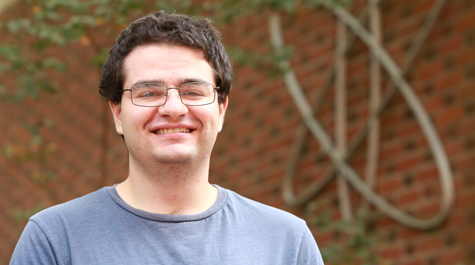DOE supports Ph.D. student Kovner’s continued QCD studies at JLab
The protons and neutrons of atomic nuclei are themselves constructed of quarks held together by gluons.
That quark-gluon relationship is governed by the strong interaction, one of the four elemental forces of nature. Quantum chromodynamics, or QCD, is one of the leading theories for describing just how the strong interaction works.
Daniel Kovner, a doctoral student in the Department of Physics at William & Mary, will continue his investigation of quantum chromodynamics as one of 65 graduate students supported by the U.S. Department of Energy’s Office of Science Graduate Student Research (SCGSR) program. The DOE Office of Science made the announcement in a recent press release.
“The DOE Office of Science provides the scientific foundation for solutions to some of our nation’s most complex challenges, and now more than ever we need to invest in a diverse, talented pipeline of scientists, engineers, and entrepreneurs who can help us build a brighter future,” said Harriet Kung, deputy director for science programs in the DOE’s Office of Science. “These outstanding students will help us tackle mission-critical research at our labs as this experience helps them begin a successful and rewarding career.”
The SCGSR program pairs grad students with a sponsor in one of the DOE’s 14 national laboratories. Kovner will work on his doctoral dissertation at the Thomas Jefferson National Accelerator Facility — JLab, in Newport News. His advisor at William & Mary is Professor Konstantinos Orginos and his SCGSR program sponsor is David Richards of the theory center senior staff at JLab.
“There is a lot of collaboration on any of these projects,” Kovner said. “So, hopefully I won’t be working just with Dr. Richards, but with the entire theory group at JLab.”
Kovner’s approach, and that of many other physicists, is known as lattice quantum chromodynamics. He explained that lattice QCD gets around a set of difficulties involving composite particles like neutrons and protons and checking out how the quarks and gluons inside are bound.
“The idea of lattice QCD is to numerically simulate the properties of these bound states so that you can describe these states from first principles,” Kovner explained. He went on to say that lattice QCD is a promising avenue of investigation, but it’s a very computational method.
“You need heavy supercomputing to really extract these properties we want to describe,” Kovner said. “Finally, we have enough supercomputing power. And I’ll be using the computing resources at JLab and several other facilities to really get at these things from first principles.”
The SCGSR program provides Kovner and other awardees with supplemental funding to complete their dissertation research at one of the DOE’s national labs. The DOE release stated that awardees were selected from a diverse pool of graduate applicants from institutions around the country. Selection was based on merit peer review by external scientific experts.















